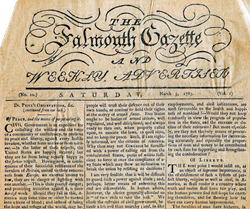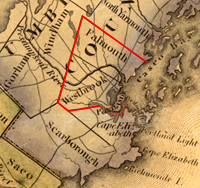-
-
-
-
Falmouth Retrospective—April 2021
-
-
-
-
-
-
About Falmouth - Retrospective—April 2021
Maine’s First Newspaper Tells Us About Life in Falmouth Two Centuries Ago
William Wooldridge of Suffolk, Virginia, recently donated an early issue of the Falmouth Gazette and Weekly Advertiser, Maine’s first newspaper.
The Gazette was a sign of the times. The Revolutionary War had come to an end just two years before. Falmouth had borne the heaviest burden of any town in Maine during the struggle for independence. The central market and seaport—today Portland’s Old Port—were destroyed in a British attack eight months before the colonies declared independence. The threat of another attack by British ships in the Gulf of Maine caused many families to move away from the coast and rebuilding did not begin until the war was over. Falmouth endured more hardship by sending men, supplies and ships to support the fight. By
1785, Falmouth was rebounding from the war. People were returning and
the town was being rebuilt. The establishment of a newspaper was a
symbol of a town on the rise. |
| Henry Dunnack, Librarian at the Maine State Library, captured the significance of the Gazette in his Book of Maine (1920, Augusta, Maine): Our issue of the Gazette is not historically significant but—like many of our artifacts—it is a tangible link to our past. It is also a window into the lives and times of the people who lived in Falmouth 236 years ago. For those with deep roots in Falmouth, issues of this newspaper were held, read, and debated by our ancestors. Click here to view the document containing full-sized images of the Gazette. Because small portions of the issue are missing or illegible, the document includes microfilm images from a fully intact copy of the same issue on facing pages. By changing your viewer settings for View / Page Display to “Two Page View” the facing pages will be shown side-by-side. Mr. William Wooldridge donated this issue of Gazette to the Falmouth Historical Society. He is a retired vice president of Norfolk Southern Railway. He has a longtime interest in state, local, and family history. A graduate of Harvard College and the University of Virginia School of Law, he served in the Army during 1969-1973. He is the author of Mapping Virginia, From the Age of Exploration to the Civil War. He has served as a trustee of the Virginia Historical Society, as president of the John Marshall Foundation, president of the Norfolk Historical Society, and on the boards of public radio station WHRO and of the Library of Virginia Foundation. |
Retrospective: Two Pictures Recall the Life of a Falmouth Schoolmaster




 Falmouth in 1785 consisted of the present-day cities of Portland and
Westbrook as well as today's town of Falmouth. Cape Elizabeth, including
today's city of South Portland, had split off in 1765.
Portland would break away in 1786 with Westbrook following in 1814.
Falmouth in 1785 consisted of the present-day cities of Portland and
Westbrook as well as today's town of Falmouth. Cape Elizabeth, including
today's city of South Portland, had split off in 1765.
Portland would break away in 1786 with Westbrook following in 1814.